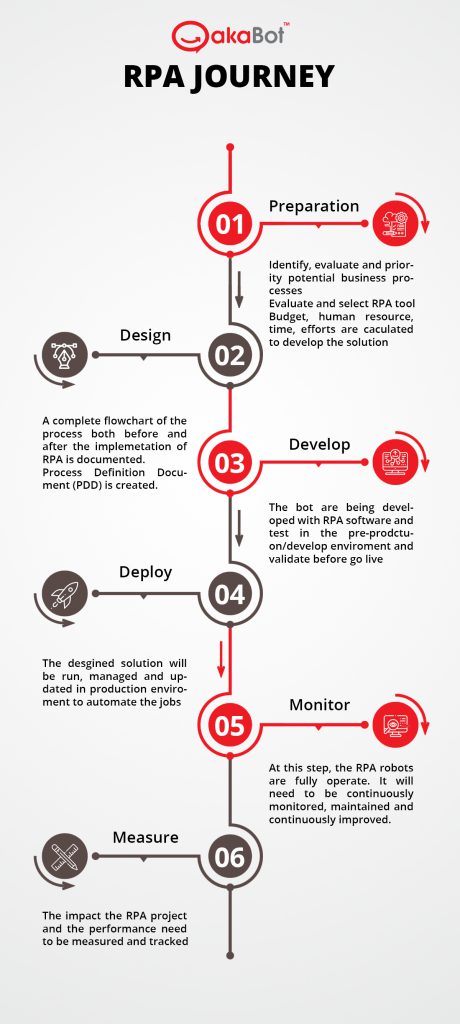Implementing RPA is a challenge of its own. While it might seem daunting to transform your organization, whether one process at a time, or a 360-degree digital movement, you should know that there is a team fully dedicated to make that vision come true and make sure you hit your target goals. They are called an RPA ‘Center of Excellence’. Read more to learn how they’re created, who’s involved, and where they fit in your RPA journey.
Mapping an RPA journey
Robotic Process Automation (RPA) is becoming a vital technology in each and every enterprise’s digital toolbox. Its benefits include boosted productivity, cost-saving, improved customer experience, among others.
If you are ready to embark on the RPA journey, take a look at a roadmap for an RPA project.

Source: akaBot
A typical RPA journey has 6 steps:
- Preparation:
Basically, everything you need to get started, from financial to human resources, and don’t forget to identify automation areas, set clear goals and align your RPA project’s outcomes with the overall organization’s goals.
- Design:
Create a Process Definition Document (PDD), which essentially is a Before-and-After description of the intended process. The PDD ensures you know exactly what is being automated, and how. Think of it like an onboarding manual for a new employee who’s taking over your old job, whom in this case is the RPA ‘bot’.
A basic PDD outline has four main parts:
- Outlining the specific manual actions to complete a process, and where they take place i.e Excel
- Drawing up a flowchart depicting the steps needed in the process, starting and ending with two ovals and as many rectangular boxes in between. A simple process can be drawn into a flowchart like this:

Source: Packtpub
- Detail the process the best you can. This is often the most tedious yet helpful step where you need to document every mouse click, text box, and any other interaction on the interface of the system. The more detailed the better, as it will help your RPA implementation team visualize how the process is typically done. To save time, you should consider screen-capturing each step, or record the whole thing into a video.
- Plan for exceptions is never redundant. In this last step of creating a PDD, jot down some of the anomalies that the robot might face while automating, i.e the robot might not find the information it needs to move on. This way, your implementation team covers all possible outcomes better.
3. Develop:
Develop the bots to roll-out process implementation, test them in appropriate environment and validate before the automated process goes live.
4. Deploy
The automated process starts running while being managed through a center of control and continues to be updated to adapt with new changes to the process
5. Monitor
The operating bots are monitored and maintained for continuous improvement.
6. Measure
The organization comes up with measure and continues to track the performance of the RPA project.
What is a Center of Excellence?
Definition:
A Center of Excellence (CoE) is a governance structure that provides leadership, best practices and support for any business initiative.
RPA Centre of Excellence is a team of RPA expertise with clearly defined roles responsible for the operation and scaling of your RPA projects.
According to Blue Prism, an effective CoE needs to:
- Align with the organization’s digital transformation goal
- Involve technical expert at some level
- Set a clear definition of success and execution steps
- Understand and identify the right processes for automation

Benefits:
A CoE can provide numerous benefits for an organization. It brings different departments and functions together to share resources and knowledge, preventing them from working in silos. By establishing a Center of Excellence, organizations can also expect:
- Standardization of deployment framework, making implementation time faster. i.e an RPA’s Center of Excellence would make sure the project is executed with purpose, plan and necessary resources to be successful.
- Definition of requirements, hence optimizing resources required
- Alignment of goals between both the IT and business sides of an organization, preparing to address challenges with a plan
- Change management by sharing effective working method, fostering teamwork and collaboration
- Consistency in how different departments serve customers and create new products.

Who’s involved in an RPA’s Center of Excellence?
- RPA Solution Architect: responsible for selecting the right technological tools, defining the initial infrastructure setup and overseeing the whole project from start to finish to make sure the solution is aligned with the business requirements. They also make sure that the project is following best practices and ready for the final delivery.
- RPA Business Analyst (BA): responsible for identifying and prioritizing business processes for the project. They create the process definition document and process maps that will be used for the development of the process. Furthermore, BA will act as the communication bridge between the business side of the organization and the RPA development team, listing and clarifying the business requirements and translate it into RPA criteria.
- RPA Developer: responsible for designing, developing and testing the RPA bots using RPA software tools, supporting the implementation of the project
- Implementation manager: responsible for the whole project by setting up and managing the team resources. They are the single point of contact for all stakeholders outside of the CoE and responsible for presenting the RPA business case to the higher-up level.
- Infrastructure manager: in charge of setting up, installing and troubleshooting the infrastructure (software and hardware) for all stages of the RPA project.
- RPA Support Service: provides support to the users working with the RPA robots and participates with the managing of the solution during maintenance stage of the project.

Source: Freepik
How to build an effect Center of Excellence
Don’t know where to start? Let us break down the three most crucial steps for you.
- First, establish a Robotics Team:
This team is comprised of your best technical experts. They are responsible for standardizing processes and procedures, measuring business metrics and performance goals, and achieve your desired ROI and customer satisfaction.
- Next, planning a roadmap:
Everything from technical, organizational and cultural sides of the organization should be thought out in long-term. This also includes the departments involved, the reporting structure within and between them, etc.
- Creating a governance:
Resources and guidelines are provided in details in this step to help foster collaboration between departments and functions involved in the project. One of the most important guidelines is how change management is rolled-out. A couple of points to address are:
- Assuring full cooperation and buy-in from key stakeholders
- Communicating effectively all RPA’s activities, key milestones and stakeholders’ needs.
- Creating an Employee Engagement plan to educate employees of the new humans and machines working structure.
- Setting measurable KPIs for performance evaluation
- Determining best practices for the future
- Lastly, a CoE should strive for Continuous improvements:
Staying on top of the newest technology wave by incorporating advancements in each RPA activity and implementation as they appear.

A Center of Excellence is a crucial pillar of a successful RPA implementation. While you might find following these guidelines somewhat intimidating, or worry your organization might lack some of the resources, partnering with a trusted RPA vendor like akaBot that understands your needs, weaknesses and strength will be a wonderful place to start.
Check out our comprehensive RPA solution from assessment, implementation to maintenance.
Start your automation journey with ease, right here at akabot.com
Sources:
- The process definition document (Packtpub)
- RPA Center Of Excellence (CoE): What You Need To Know For Success (Forbes)
- RPA Center of Excellence (Kryonsystems)
- Building a Center of Excellence to Drive Your Enterprise-Wide RPA Strategy (ChazeyPartners)
- Why You Need a Center of Excellence (Automation Anywhere)
akaBot (FPT) is the operation optimization solution for enterprises based on RPA (Robotic Process Automation) platform combined with Process Mining, OCR, Intelligent Document Processing, Machine Learning, Conversational AI, etc. Serving clients in 20+ countries, across 08 domains such as Banking & Finances, Retails, IT Services, Manufacturing, Logistics…, akaBot is featured by Gartner Peer Insights, G2, and ranked as Top 6 Global RPA Platform by Software Reviews. akaBot also won the prestigious Stevie Award, The Asian Banker Award 2021, etc.
Leave us a message for free consultation!

